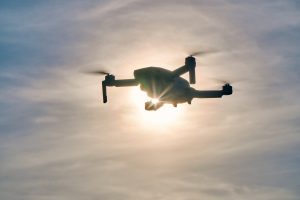Table of Contents
Overview
It’s no question that the DJI Mavic Series is one of the most sought-after and popular units of drones in the market today. These excellent drones are known for their impressive specifications and functional features. The DJI Mavic drones are indeed superb, reliable, and packed with significant innovations.
This post will generally be talking about the range of the DJI Mavic drones and other important information that you might want to know. So, if you desire on learning more about the DJI Mavic Series’ range, we can say that you have come to the right page.
DJI Mavic Series
The DJI Mavic Series includes robust and foldable units that are fit for every aerial adventure. The DJI Mavic Series consists of six awesome drones, and each of them is unique and impressive.
DJI Air 2S
The Air 2S comes with a 1-inch camera sensor fit for up to 5.4K UHD video and boasts a transmission range of 12km. This unit also has an intelligent shooting mode that makes the DJI Air 2S an all-in-one film crew that can easily record all your aerial moments and adventures.
DJI Mini 2
The DJI Mini 2 is considered to be the small but terrible one. This unit features 4K videos, a 4x zoom capability, and allows you to take gorgeous panoramas. The DJI Mini 2 has a transmission range of 10km at a maximum.
Mavic Air 2
The Mavic Air 2 features a better and improved 48MP camera that lets you take magnificent and spectacular aerial shots. This awesome drone features OcuSync 2.0 that provides a range of up to 10km video transmission. It also has an impressive flight time of all Mavic series drones.
Mavic Mini
This is an ultra-light but very reliable drone from the DJI Mavic series. This unit is straightforward and easy to operate and allows you a maximum flight time of 30 minutes. The Mavic Mini boasts a 4km HD Video transmission with a vision sensor and GPS precise hover.
Mavic 2 Pro and Zoom
These two bad boys are one of the most sought after drones in the Mavic Series. They are advanced with features like obstacle detection, collision avoidance, and with improved cameras. They come with a 12MP 2x optical zoom lens and a range of 8km video transmission.
What drone has the most extended range?
Among the DJI Mavic Series members, the Mavic Air 2 has the most impressive and the most extended range there is. This unit features an improved 48MP camera with extra modes such as SmartPhot and 8K Hyperlapse to help you develop magnificent and fantastic shots. The performance of this long-range drone is also outstanding and impressive. This unit gives up to 10km of video transmission and has the longest flight time among the DJI Mavic Series.
What is the range of the DJI Mavic 2 Pro?
The Mavic 2 Pro is still one of the most famous items in the camera drone industry nowadays. Many drone enthusiasts and hobbyists enjoy how this fabulous unit can capture stunning and high-quality images even in low light situations and environment. The Mavic 2 Pro, just like the Mavic Air 2, features an OcuSync 2.0 transmission that can offer a 1080pm Livestream with a range of 8 km. This drone has a maximum flight time of up to 31 minutes, which is impressive.
What happens when your drone flies out of range?
We all know that drones, no matter how awesome they can be, still have limited range. When your drone flies out of range, you will eventually lose the transmission or signal you need to control your drone. That means you can no longer control or maneuver your drone. However, not all drones are the same. Some low-technology drones may crash and fall somewhere once they go out of range. The high-technology and more expensive drones, on the other hand, will not immediately crash somewhere. The DJI drones, for example, have features that will prevent unwanted crashes from happening.
Nowadays, most good quality drones already have a memory GPS that lets them store their home location. With this feature, the drone will record its initial position as its home and allow it to return to the same place or within proximity where it took off. If you have gone too far and your drone flies out of range, you will be alerted through your remote controller, and at the same time, your drone will attempt to return through the path that it took until it can regain signal.
Many drones already have and RTH or return to home features, which can be manually activated through the remote control. This allows your drone to return to you through the location that is saved. However, when the battery is extremely low, and there might be not enough time for it to return to you, there is still a chance that your drone can crash or be lost somewhere. It is essential that you know your drone’s approximate location based on the GPS or video feed so that you will be able to retrieve it quickly and safely.
Tips for flying a long-range drone
Here are some tips that you might want to take note of when flying a long-range drone.
Drone regulations
We have said this before, but we would like to remind you again that you always have to check and be familiar with the drone regulations and local laws of the place where you plan to fly your drone. There are places and instances that you might not be allowed to fly your drone, such as in private properties of in nature reserves. Always remember to fly within your line of sight.
Weather conditions
Before flying your drone, you might want to check on the weather conditions throughout the day. Bad weather can negatively affect the transmission signal and might result in losing control over your drone. It is generally recommended for you to fly in sunny and bright weather conditions. You can quickly check the weather through the morning news or some apps you can install on your phone.
Temperature
The temperature can significantly affect the discharge and performance of your drone batteries. That means the length of your flying time can be adversely affected if the temperature is high. Always remember to fly with fully charged batteries and fully functional batteries. Monitoring your drone battery’s life status is also crucial.
Obstacles
Tall trees, buildings, and other structures might cause interferences when these structures come between you and your drone. Interference will affect transmission quality and could often cause loss of signal. It is a good idea to fly your drone in open spaces and away from many people and large objects.
Monitor flight
When flying your drone, especially when it is a long-range one, the most helpful and vital tip is to stay alert and monitor the flight performance through your remote control or the app. Always remain attentive and keep your presence of mind, especially during strong and gusts of wind or if you see any birds nearby.
Bottomline
The DJI Mavic Series drones are indeed super reliable with a trustworthy range and impressive flying time. If you plan to get long-range drones, you must know the critical factors you should consider before getting one. This includes your budget, maintenance, your usage, and your skill in controlling a long-range drone as well. Drones are indeed very awesome, and buying one could help you enjoy a good deal of adventure too!

